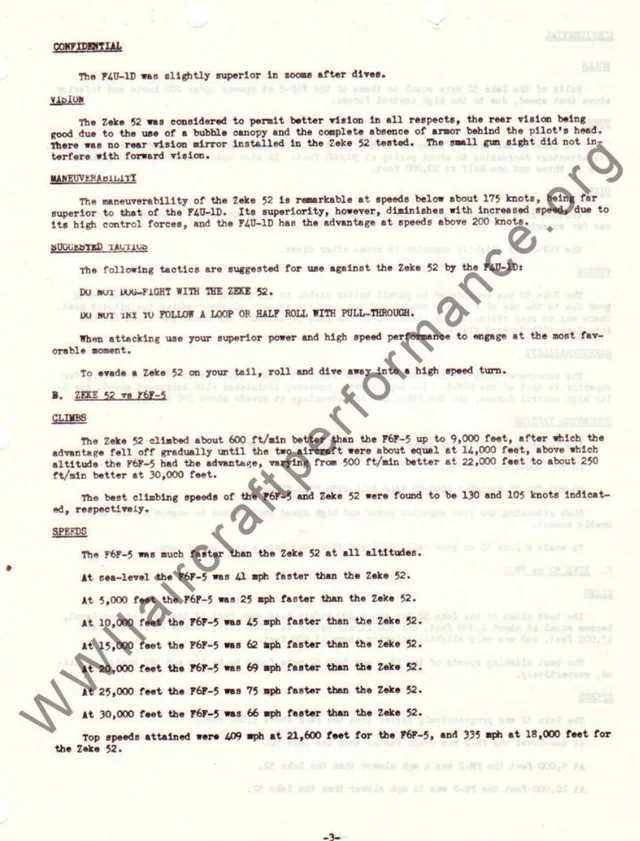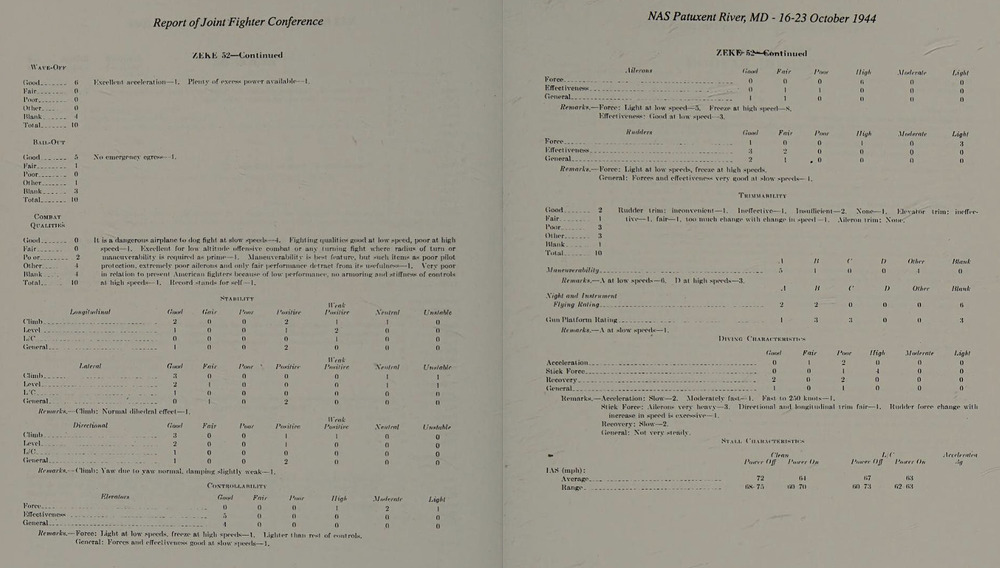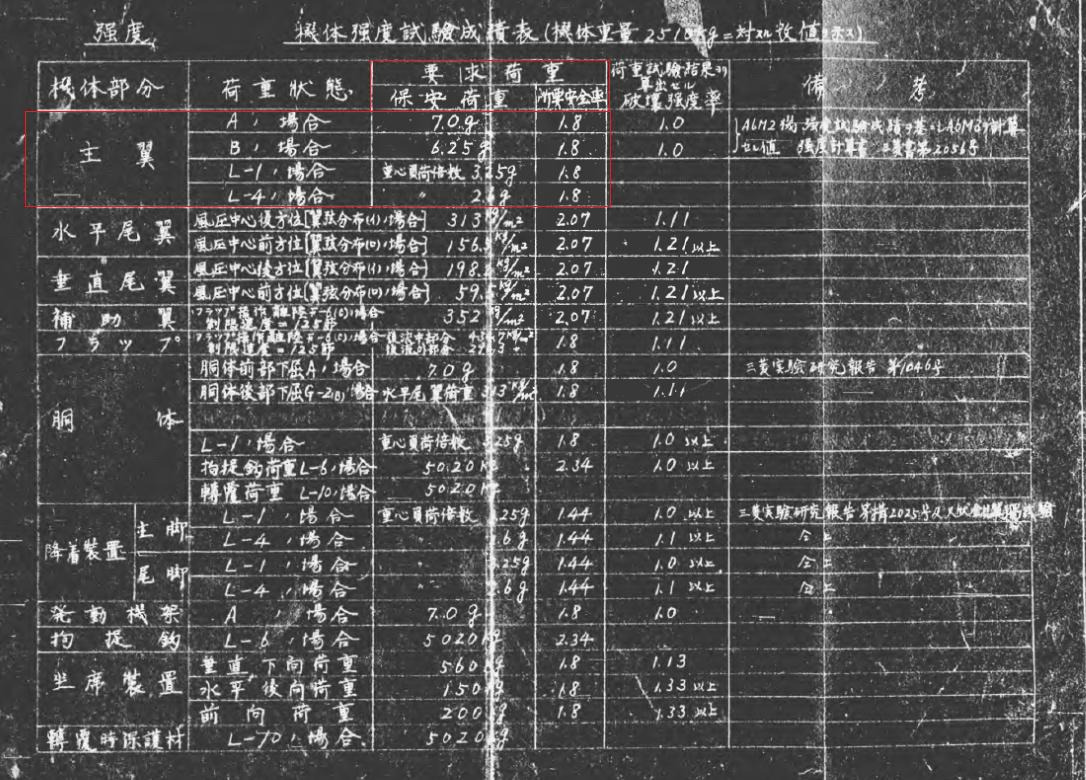By all accounts, the zero GROSSLY overperforms, and Gaijin has done nothing about it. Not only for the Gs it can pull, but for its VNE (never exceed speed limit), and its high speed performance. In reality, the Zero performed VERY well… at speeds under 200 mph. Once it reached 217ish mph it manually locked performance, because if it didn’t, any major maneuver would literally rip the wings off. Pulling anything over 9 Gs would physically rip the wings off. There is Zero(haha) good reason for this in game. Historically, at “high” speeds (just 250mph) the corsair and hellcat outmaneuvered the zero on all accounts, but in game this does not track.
Every plane experiences control stiffening. At least for A6M5, until ~450kph/280mph it was well ahead of everything else. Earlier models were lower, not by much. The control system stayed relatively unchanged.
Ultimate load limit was the same as USA fighters, 12G. That is before accounting for any safety factor for a “safe” limit.
By the way even the A6M2 is lacking top speed due to faulty testing of a captured example which did not run the engine to its full manifold pressure, only up to military power. Thus we have a top speed of 510kph/316mph instead of 555kph/345mph at “overboost” (WEP) that Saburo Sakai mentions in his book; in it he also states that 510kph is the top speed of a Model 21 Zero running at “normal full power”.
This document on the A6M5 begs to differ.

Also, i checked multiple sources, and they all say that US tests and Akira Yoshimura, a Zero pilot say that the ailerons of the A6M5 became very heavy at just 180 mph, and at 230 mph, it was a struggle to even slowly roll the aircraft.
No one argued that they don’t. The argument is that the Zeros stiffening was MUCH stronger than any at least US or British plane it fought at high speeds.
Here, the safe wing load is stated as 7.0 with a safety factor of 1.8.
Never argued this. But either way, being able to fly a certain speed has zero guarantees for maneuverability at those speeds.
With all this said, your arguments amount to nothing when it comes to disproving me, because it all comes down to “Historically, the Zero was absolutely decimated by Hellcats and Corsairs, having a kill ratio of 13:1 and 12:1 respectively, just against Zeros. All testimonies state that at around 300 mph, the official engagement speed, the Zero could not maneuver anywhere close to the Corsair or Hellcat. This doesn’t translate in game in the very slightest. Zeros pushing 500 IAS without breaking, remaining hyper maneuverable even at the brink of VNE, almost no noticeable stiffening all the while, I checked. But the same cannot be said for the Corsair and F6F which will lock up a hell of a lot at around 400 mph, which i also checked.” And I’ll tell you, I found no major discrepancies with the flight model of those two aircraft. If the Zeros performance is as good IRL as it is in game, there is no reason why specifically the Hellcat and Corsair decimated them in engagements. And don’t give me the “less experienced pilots” excuse, because that happened because of the Hellcat and Corsair.
tbf Spitfires kinda have similar issues. It’s he crew’s G resistance and Stamina to blame.
Completely new crews without crew skills, no expert and especially no acing behave somewhat plausibly. Introduce an Ace crew and you can camp a 6G turn indefinitely at hundreds of kilometres of IAS (700). No vignetting. Nothing.
And you can also slam a plane into the ground and yank the stick back into your guts to exceed 11Gs and do a 360 degree stupid-turn and barely ride the edge of passing out in a Mustang Ia.
This states notable maneuver superiority of the A6M5 at speeds below 175kts, or about 324km/h / 200mph compared to the F4U-1D. Then it notes that heavy controls make sure the F4U-1D has the advantage past 200kts (370km/h / 230mph).
This does not mean the Zero locks up completely, just that at these higher speeds the F4U-1D would have the advantage.
In game the “issue” is mainly the Corsair bleeding speed, very easily dropping into the range where the Zero has the advantage.
Taking the stated 7G limit and applying the safety factor of 1.8 gives a 12.8G structural limit, still well above the G loads it pulls in game.
Why do you assume sustained turning engagements at thise speeds? Instead what is happening as that at 300mph+ (482km/h+) the Zero would lack the ability to sufficiently defend against a pass from the faster American fighters that at these speeds can use their superior control authority to keep their guns on target.
In a sustained turning engagement, even one initiated at these speeds, they would still lose their speed and end up at a disadvantage, which is the exact reason such fights were actively discouraged.
Simply put, if the guns aren’t on target in the first pass, do a second pass. Better high speed performance only lasts for as long as you are at high speeds, which isn’t long if you try to turn to the best of your abilities.
Add to all this the absolute superhumans that are War Thunder pilots, and you get what we currently see in game.
My source is Planes Of Fame and their restored A6M5, done with the help of the original designer Horikoshi.
Also, which model? Which wing, clipped or rounded? Which wingspan?
That will be a little over 12G. I’m sure you can read the part where I said “before any safety factor is accounted for, for a safe load factor”.
This also changes with weight, and a P-51 at high loads will be limited to little over 6G.
No, however they’re still slower than they should. And that report says nothing about sustained turning ability, only that it is slow to react.
US reports are also very suspicious, I was looking into Model 21 tests a while ago and one of the US tests had the plane running only up to ~2000rpm instead of the 2500rpm it is supposed to achieve. Still outclimbed a P-40K in that scenario.
Another captured example was unable to use overboost.
The fabled Akutan Zero had several faults, such as landing gear doors that didn’t close fully.
In light of all that I will very much trust the words of people who have restored a Zero to like-new condition, over such intelligence reports.
Good thing that I’m not talking about kill counts IRL, I’m talking about the plane’s flight performance and how it would translate to its in-game capabilities.
in fact that would merely get the Zero to go lower in BR relative to those two.
Yes, and in-game the F4U-1 is at BR 2.7, while the A6M5 is at BR 5.0. With these nerfs, is the A6M5 also gonna move down to 2.7? Maybe 3.3 where the Hellcat is? But since it was losing IRL, why shouldn’t it go lower?
Of course, none of that BR adjustment would happen because USA mains would still get absolutely blasted, as they are now, and inevitably drive up its stats. It doesn’t matter what you do to the Zero. 280mph is a lot of speed in such a fighter.
As long as its BR is lowered, by all means nerf it to handle poorly above 280mph. I’ll be sure to enjoy a Zero that has an engine maybe worthy of its battle rating.
A6M2 at 3.7 which can meet F8F Bearcat at 4.7…
The maneuverability of jp planes looks iffy. Especially in arcade, where all stats are buffed, but also in RB. It turns so narrow that it just loosk like comedy. (also some ru planes)
As if G Force don’t exist in WT. Neither for the airframe nor the pilot (!).
Which is generally what you get when your pilots have superhuman durability and nobody cares about structural degradation until the wing literally falls off. It’s the same effect we see at higher tiers where it’s normal for aircraft to maneuver at 10+Gs sustained.
Personally I don’t think there really is a way to fix it, most players would be annoyed if pilots had normal human durability and they were somehow punished for causing too much stress on their aircraft before the breaking point.
And your point is…? In game, the Zero still has superior controls at those speeds!! And i never said it locked up completely??
This isn’t about passes, its about a high speed dogfight. These rules apply whether the zero is in front of or behind you, and they work as such. You think that zeros were never the ones getting the drop on a hellcat or corsair? And i never said anything about sustained turning engagements. In game, the zero does not lock up in any significant capacity. Like at all. Not at 300 mph, not at 400mph. You can quickly pull out of a near VNE dive lickety split. But you know what? The Hellcat and Corsair both lock up at 300 and 400mph. You cannot cut it in any way where the Zero is more maneuverable than the Hellcat and the Corsair at all speeds in game. Go ahead and maneuver at those speeds with the respective aircraft and come back to me and tell me how that historically makes sense
The saftey
You probably shouldn’t do that, because there is no way of knowing if the restored Zero, which was constructed with 30 years more of intelligence of aviation laws, technology, and all focused on a single aircraft to make it perfect, than a typical factory mass production built plane, in the early 1940s.
Use the Zero, F4U, and F6F in war thunder and do any maneuver at high speeds, 300 to 400. Rolling, turning, barrel rolls, the works, and tell me which performs better at those speeds. And when you do that ask yourself, does that flight model at that speed square with every single report on the performance of the most famous, widely used, and most manufactured fighter plane in all of Japanese world history at those speeds?
Brother, downplaying the ability of the technology of your enemy in at time of war would be the stupidest thing imaginable. They didn’t max out the RPM because it was the ONLY ZERO THEY HAD AT ALL at the time. You’re not going to stress test that shit. And even then, I really don’t care about its engine power, i’m talking about its controls, which by all accounts, japanese and american, had its performance drop off and suffer around 180mph to 200mph. It only became SIGNIFICANTLY worse at 280, which also in game, does not square at all.
At least we can agree on this point. I’m not mad about it because of anything to do with BR, I’m frustrated that this fuckin thing behaves NOTHING like i’ve seen anyone talk about it historically. I want historical accuracy in my game above filling some BR slot.
???
The whole point of the restoration was to not change anything not absolutely necessary - they even kept the original Sakae engine. Why would they go through all that trouble… if they were just gonna change other parts anyway?
I never said the Zero handled realistically. Just that your numbers were way off and the pristine, like-new plane restored by Planes Of Fame is far more accurate than one repaired halfway into the war after serious damage, at a point where very little was known about the Zero and they certainly did not have support from the original designer himself.
I also never claimed they should have done otherwise. However, it brings into question the validity of the entire test.
If something so basic as engine RPM or manifold pressure, directly measured by the aircraft instruments, could not be operated to their intended, design limits… What was the actual condition of the test aircraft?
And it completely writes off any performance figures obtained. It makes no sense to use ANY performance figures obtained in a test where they couldn’t even get the engine running right.
And again, by the testimony of the people with a Zero restored as close to original as possible, with the help of the original designer… it only starts losing its edge above 280mph.
As I said above, if they were unable to get the engine running right despite it not being a complex powerplant, what else did they get wrong and were unable to even notice it was wrong?
It wouldn’t be the first time this was done. Allied tests of Bf 109 Es have to be approached very carefully because one example was already worn, got crash-landed, was repaired, and before the british got their hands on it for more testing, the french did them the favor of burning out the engine by climbing to a rather high altitude with the radiators closed all the way and at the maximum power setting.
Would you take the numbers of either the british or french tests of that aircraft at face value and apply them to the in-game Bf 109 E? I know I wouldn’t, because they’re obviously flawed.
Have you done this amount of… ‘criticism’ for any of the other inaccuracies? By all accounts, at high speed a Fw190 should outturn a Spitfire, even a Mk9. I don’t remember this being the case, ever. They also overheat tremendously even on the post-cowling redesign models which fixed that issue, and are unable to do any of the hard maneuvers they were able to do IRL.
In Sim, all F4U-4s have ridiculous handling; some of this bleeds over to RB and maybe even AB where it can get and maintain nose-up attitude well below stall speed, unlike almost any other plane regardless of them having better P/W or lower stall speeds of their own. This is despite the Corsair in general being known for being very ‘tippy’, with unforgiving stall characteristics.
And of course, there’s the XP-55 being perfectly stable and not trying to kill you anything you touched the controls.
Anyway, I can’t wait for my 2.7 BR Zeros.
Chuck Yeager himself said the Fw190 was a very good plane, so it should be better ingame
Real!
That plane they made in the 1970s really isn’t convincing when it comes to performance, when i assume they wanted flyability and safety over absolute historical accuracy. And i have seen no evidence to show exactly how its supposedly sooo accurate.
I see all the other stuff your saying, and honestly i just don’t really care anymore now that you’re doing whataboutisms about shit i never mentioned, and bringing up a zero built up in the 1970s over and over again while not addressing the problem of how they grossly overperform anyways even given your claims are true.

The very Zero52 in the Planes of Fame Museum was a test subject during the Joint Fighter Conference, before it was rebuilt in 1970s. The flight tests been made by various pilots during the conference draw the same conclusion that the airplane’s manoeuvrability was of class D in high speed, control frozen at high speed and slow dive recovery.
The A6M’s manoeuvrability wasn’t overwhelming, there are a lot of factors that the WarThunder couldn’t include.

One shouldn’t think the aircraft’s aerodynamic property to be static, the lift coefficient and oswald change with respect to airspeed and specifically the Mach number.
Reasons for A6M’s lack of high-speed manoeuvrability:
- Sensitive to Mach effect, loses lift coefficient and drag property, meets compressibility very early and thus degrade its manoeuvrability, and its dive speed limit.
- Lightly built airframe in conjunction with large aspect-ratio making it vulnerable to aeroelastic deformation. The A6M’s wing was built with a twist angle, and high load will twist the wing even further beyond the design position, causing a drop of lift coefficient, also causing the control reversal on ailerons which was notorious during the A6M’s service span.
- Control traction lack of elasticity, which was a request from the IJN and pilots to ensure safety and control characteristic(A6M is very stable at low speed), thus a feature, not a bug.
They did not “make” a plane.
So they would have gone with an R-1830 which has far more technical information, parts, and expertise available for it than a Sakae. But they didn’t.
It’s almost as if I did, and you probably just died to a Zero before making your first post anyway.
This is actually very informative, thank you. This is what I assumed, but where did you get these reports? I’d love to see more findings from this.
Yeah, i think that Gaijin needs to tone it down with how many gs pilots can pull. And the fact that you can still see and maneuver WHILE blacked out is absolutely ridiculous.
Don’t nerf Zero please. They are already Terrible experience to play, everybody just BnZ you and you cannot do anything due to lack of speed. And you want make it even worse?


